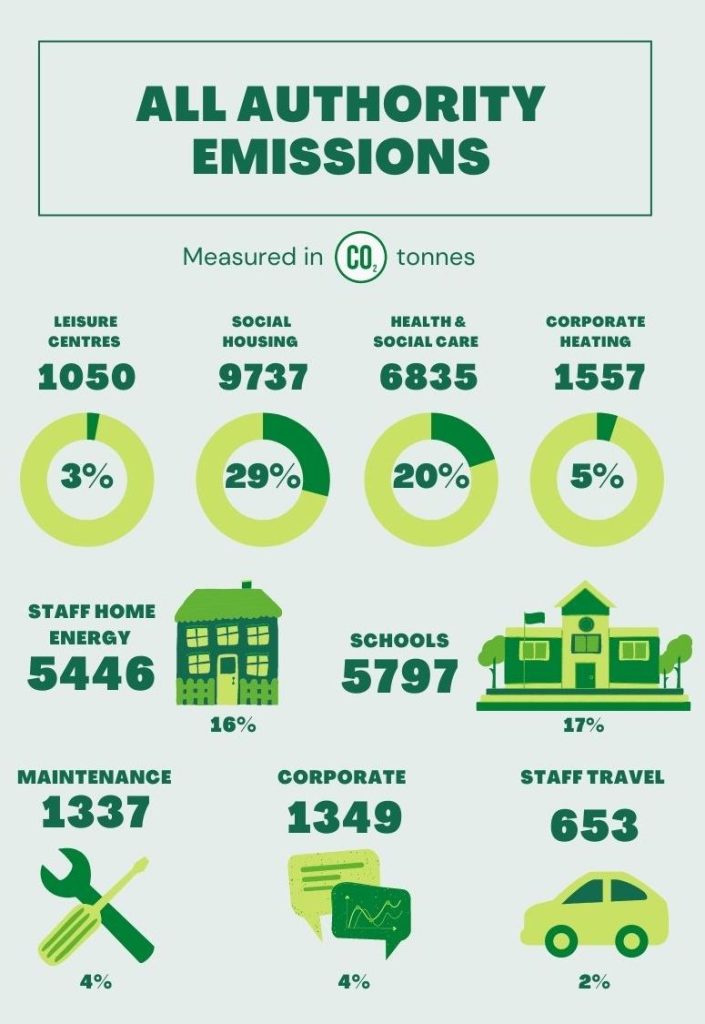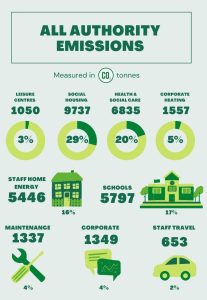Switch to green energy saves council’s carbon footprint
New figures show Shropshire Council’s switch to green energy suppliers has resulted in a 100% reduction in its carbon footprint for electricity.
The council’s climate action team is reporting a 62% drop in carbon emissions created by corporate heating, fleet transport and electricity.
It says Shropshire Council’s direct carbon emissions in these areas have fallen from around 5,000 tonnes in the financial year 2020, to around 1,900 tonnes in 2021. The drop is due primarily to the adoption of a 100% renewable power supply through West Mercia Energy, as well as the effect of the pandemic on services it provides.
The action team has shown how Shropshire Council has:
- Powered down by improving energy efficiency and reducing carbon emissions from buildings and transport
- Powered up by working with others to generate more renewable energy
- Saved at least 300 tonnes of carbon through the free tree scheme, which has seen more than 140,000 trees and hedgerows planted in just 10 years, and by managing council owned land specifically for that purpose.

All council emissions
Ian Nellins, Shropshire Council’s Cabinet member for climate change, natural assets and the green economy, said:-
“Shropshire Council is in a position to make a strong positive contribution to help the wider Shropshire community make a positive transition to a low carbon future.
“The council’s corporate footprint represents only around 1% of Shropshire’s total carbon footprint, but the council can influence as much as 33% of emissions through its regulatory and support functions.
“We are committed to further action, and are already supporting a wide range of projects and initiatives designed to support local businesses and communities to reduce their carbon emissions.”
Carbon offsetting and capture activities have also increased by 12%, reflecting high levels of domestic waste recycling under the contract operated by Veolia, and the capture and storage of carbon on council-owned and council-managed land.
Some outsourced services have shown only a moderate reduction in their carbon footprint. For example, schools maintained by the council had the highest emissions with 5.8 tonnes, and the highways footprint of 0.95 tonne reflects the intensity of use of maintenance vehicles and gritters during the winter period.
Ian Nellins added:-
“While the carbon savings generated from recycling and land management activities mean that the council’s footprint is technically already net-positive, it is important that the council continues to focus on reducing its gross carbon emissions.
“A wide range of actions, projects and initiatives have been completed, are currently in progress, or are planned for future years.
“Some of these projects and initiatives are designed to improve Shropshire Council’s corporate carbon performance, whilst others are designed to help Shropshire businesses and communities make the transition to a low carbon approach.”
Work in progress includes more electric vehicle charging points across the county, working with housing associations to retrofit homes with low carbon heating, and energy saving measures and reducing fuel poverty, exploring local heat network opportunities and renewable energy generation.
Shropshire Council declared a climate emergency in May 2019, and in December 2020 adopted a Climate Strategy and Action Plan, which establishes the objective of achieving net-zero carbon performance for the council by 2030.
The climate action team will present its first annual report to Full Council on Thursday (13 January 2022). (Also click here)


